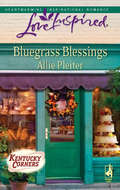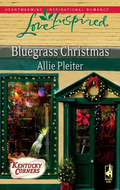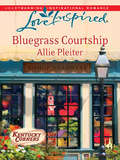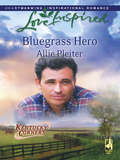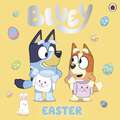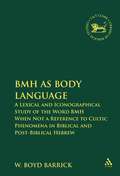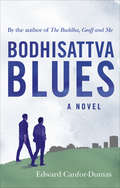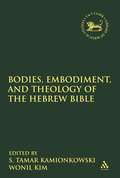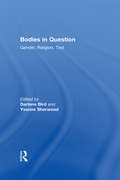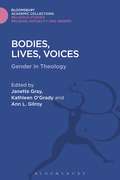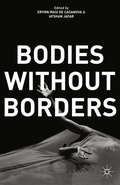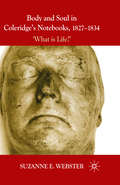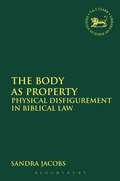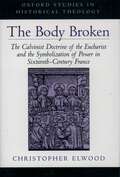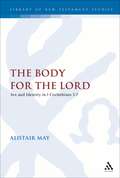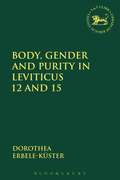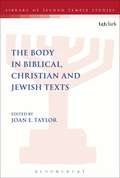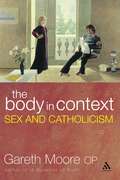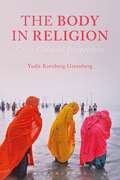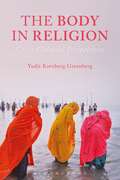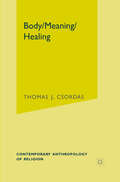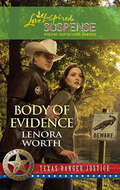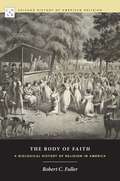- Table View
- List View
Bluegrass Blessings (Kentucky Corners #3)
by Allie PleiterEveryone in Middleburg, Kentucky, lines up for baker Dinah Hopkins's cinnamon rolls. Everyone except her handsome new landlord, Cameron Rollings. The jaded city man doesn't like anything about small-town life–from the fresh air to her fresh-baked snickerdoodles. And he clearly considers Dinah as quirky as her eccentric oven.
Bluegrass Christmas (Kentucky Corners #4)
by Allie PleiterAn Old-Fashioned Christmas That's what led new believer Mary Thorpe to start over in quaint Middleburg, Kentucky. As director of the church's Christmas pageant, Mary's job is to bring the townspeople together, to remind them what the season is really about.
Bluegrass Courtship (Kentucky Corners #2)
by Allie PleiterThe celebrity host of TV's Missionnovation, Drew Downing is comfortable with his fame. He's become accustomed to the cheering, star-struck townfolk that usually welcome him as he renovates churches countrywide. Usually. Then he and his crew set up in tiny Middleburg, Kentucky, to rebuild the church's storm-damaged preschool.
Bluegrass Hero (Kentucky Corners #1)
by Allie PleiterDust-covered men who smell like horses are the norm at Gil Sorrent's farm.
Bluey: Easter (Bluey)
by BlueyCelebrate Easter with Bluey!It's Easter and Bingo is worried the Easter bunny has forgotten about her and Bluey like last year. But when they wake up to a series of clues, Bluey and Bingo are led on an exciting Easter egg treasure hunt around the house!Join Bluey and Bingo on this fun adventure around the Heelers' home.Want more Bluey? Also available:Bluey: Fun and Games Colouring BookBluey: Meet Bluey! Sticker Activity BookBluey: Bluey and Friends Sticker Activity Book
BMH as Body Language: A Lexical and Iconographical Study of the Word BMH When Not a Reference to Cultic Phenomena in Biblical and Post-Biblical Hebrew (The Library of Hebrew Bible/Old Testament Studies)
by W. Boyd BarrickIt is customarily assumed that the Hebrew word BMH denotes a "high place," first a topographical elevation and derivatively a cult place elevated either by location or construction. This book offers a fresh, systematic, and comprehensive examination of the word in those biblical and post-biblical passages where it supposedly carries its primary topographical sense. Although the word is used in this way in only a handful of its attestations, they are sufficiently numerous and contextually diverse to yield sound systematic, rather than ad hoc, conclusions as to its semantic content. Special attention is paid to its likely Semitic and unlikely Greek cognates, pertinent literary, compositional, and text-critical matters, and the ideological and iconographical ambiance of each occurrence.This study concludes that the non-cultic word BMH is actually *bomet, carrying primarily (if not always) an anatomical sense approximate to English "back," sometimes expanded to the "body" itself. The phrase bmty->rs (Amos 4:13, Micah 1:3, and CAT 1.4 VII 34; also Deut. 32:13a, Isa. 58:14ab-ba, and Sir. 46:9b) derives from the international mythic imagery of the Storm-God: it refers originally to the "mythological mountains," conceptualized anthropomorphically, which the god surmounts in theophany, symbolically expressing his cosmic victory and sovereignty. There is no instance where this word (even 2 Sam. 1:19a and 1:25b) is unequivocally a topographical reference. The implications of these findings for identifying the bamah-sanctuary are briefly considered.
Bodhisattva Blues: A Novel
by Edward Canfor-DumasEd is stuck in a rut - his part-time 'career' is going nowhere, his love life's a joke and his wallet's always empty.The thing about a rut, though, is at least you know where you are.So when Ed runs into an old acquaintance and is sucked into a drama of street crime and high-stakes property dealings, he turns to the principles that once served him well. Except - he's not sure if he can still trust them, especially as his Buddhist practice is a bit on the rusty side...Written by Edward Canfor-Dumas, award-winning screen writer and novelist, this is an urban story with a twist and a wry appreciation of the challenges we face every day - whether we're muddling by, or, like Ed, suffering from a severe case of the bodhisattva blues...A book for everyone who's ever wondered whether enlightenment really is compatible with the daily commute.
Bodies, Embodiment, and Theology of the Hebrew Bible (The Library of Hebrew Bible/Old Testament Studies)
by S. Tamar Kamionkowski Wonil KimRecognizing that human experience is very much influenced by inhabiting bodies, the past decade has seen a surge in studies about representation of bodies in religious experience and human imaginations regarding the Divine. The understanding of embodiment as central to human experience has made a big impact within religious studies particularly in contemporary Christian theology, feminist, cultural and ideological criticism and anthropological approaches to the Hebrew Bible. Within the sub-field of theology of the Hebrew Bible, the conversation is still dominated by assumptions that the God of the Hebrew Bible does not have a body and that embodiment of the divine is a new concept introduced outside of the Hebrew Bible. To a great extent, the insights regarding how body discourse can communicate information have not yet been incorporated into theological studies.
Bodies in Question: Gender, Religion, Text
by Darlene BirdExploring a range of subjects from the human genome project to Kierkegaard's Fear and Trembling, the poetry of Jorie Graham to feminist Christian art, the contributors pose questions around the theme 'Body and Voice'. Questions raised include: 'Who speaks for the foetus and on what basis?'; 'What effect does the near-sacrifice of Isaac have on mother Sarah's body?'; and 'What do embodiment and gender mean for the resurrected body and Jesus's body?'
Bodies in Question: Gender, Religion, Text
by Darlene BirdExploring a range of subjects from the human genome project to Kierkegaard's Fear and Trembling, the poetry of Jorie Graham to feminist Christian art, the contributors pose questions around the theme 'Body and Voice'. Questions raised include: 'Who speaks for the foetus and on what basis?'; 'What effect does the near-sacrifice of Isaac have on mother Sarah's body?'; and 'What do embodiment and gender mean for the resurrected body and Jesus's body?'
Bodies, Lives, Voices: Gender in Theology (Religious Studies: Bloomsbury Academic Collections)
by Janette Gray Kathleen O'Grady Ann L. GilroyThis work lies at the critical juncture of feminism and religious studies and participates in the vibrant tradition of the feminist anthology. It is part of a broad feminist discourse that continues to grow less monolithic and more varied in material, method and style each year. The papers are divided into three main sections: the representation of women in sacred texts and theologies, the fundamental need to recover the heritage of women and to return to women their history, and the coming together of canonical texts with contemporary feminist theory in order to address philosophical and theological problems.
Bodies Without Borders
by ERYNN MASI DE CASANOVA Afshan JafarGlobalization is often thought of as an abstract process that happens "out there" in the world. But people are ultimately the driving force of global change, and people have bodies that are absent from current conversations about globalization. The original scholarly research and first-person accounts of embodiment in this volume explore the role of bodies in the flows of people, money, commodities, and ideas across borders. From Zumba fitness classes to martial arts to fashion blogs and the meanings of tattooing, the contributors examine migrating body practices and ideals that stretch across national boundaries.
Body and Soul in Coleridge's Notebooks, 1827-1834: 'What is Life?' (Health, Technology and Society)
by S. WebsterThrough an examination of his later personal notebooks, this study explores the reciprocal effects that Samuel Taylor Coleridge's scientific explorations, philosophical convictions, theological beliefs, and states of health exerted upon his perceptions of human Body/Soul relations, both in life and after death.
The Body as Property: Physical Disfigurement in Biblical Law (The Library of Hebrew Bible/Old Testament Studies #582)
by Sandra JacobsThe Body As Property indicates that physical disfigurement functioned in biblical law to verify legal property acquisition, when changes in the status of dependents were formalized. It is based on the reality the cuneiform script, in particular, was developed in Sumer and Mesopotamia for the purpose of record keeping: to provide legal proof of ownership where the inscription of a tablet evidenced the sale, or transfer, of property. Legitimate property acquisition was as important in biblical law, where physical disfigurements marked dependents, in a similar way that the veil or the head covering identified a wife or concubine in ancient Assyrian and Judean societies. This is primarily substantiated in the accounts of prescriptive disfigurements: namely circumcision and the piercing of a slave's ear, both of which were required only when a son, or slave, was acquired permanently. It is further argued that legal entitlement was relevant also to the punitive disfigurements recorded in Exodus 21:22-24, and Deuteronomy 25:11-12, where the physical violation of women was of concern solely as an infringement of male property rights.
The Body Broken: The Calvinist Doctrine Of The Eucharist And The Symbolization Of Power In Sixteenth-century France
by Christopher ElwoodThe Body Broken: The Calvinist Doctrine of the Eucharist and the Symbolization of Power in Sixteenth-Century France (Oxford Studies in Historical Theology)
by Christopher ElwoodIn the public religious controversies of sixteenth-century France, no subject received more attention or provoked greater passion that the eucharist. In this study of Reformation theologies of the eucharist, Christopher Elwood contends that the doctrine for which French Protestants argued played a pivotal role in the development of Calvinist revolutionary politics. By focusing on the new understandings of signs and symbols purveyed in Protestant writing on the sacrament of the Lords Supper, Elwood shows how adherents to the Reformation movement came to interpret the nature of power and the relation between society and the sacred in ways that departed radically from the views of their Catholic neighbors. The clash of religious, social, and political ideals focused in interpretations of the sacrament led eventually to political violence that tore France apart in the latter half of the sixteenth century.
The Body for the Lord: Sex and Identity in 1 Corinthians 5-7 (The Library of New Testament Studies #278)
by Alistair MayAlistair May explores the part played by sexual ethics and the rhetoric of sexual morality in the formation of Christian identity by focusing on the longest discussion of sex in the New Testament - 1Corinthians 5-7. Viewing this passage as a unified discourse, he considers how Paul's ethics serve to give his converts a distinct identity. Although tools from the social sciences are used, the major focus of the work is in careful exegesis of the text. As the study progresses through the text of 1Corinthians 5-7, May argues that Paul strives to maintain an absolute distinction between insider and outsider in regard to morality. Immorality belongs exclusively to the outside and to the pre-conversion identity of the Corinthians. Hence those labelled immoral can no longer remain in the community. 1 Corinthians 6.12-20 reveals that, for Paul, sexual sin is unique in its destruction of Christian identity and that any sexual participation is a potential conflict with participation in Christ. Thus, chapter 6 is directly connected with the discussion of the legitimacy of marriage in 1Corinthians 7. Rejecting the scholarly consensus that Paul is reacting to ascetics, May controversially argues that chapter 7 should be read as Paul's commendation of singleness to a reluctant Corinthian audience.This is volume 278 in the Journal for the Study of the New Testament Supplement series.
Body, Gender and Purity in Leviticus 12 and 15 (The Library of Hebrew Bible/Old Testament Studies)
by Dorothea Erbele-KüsterThe so-called purity laws in Leviticus 11-15 reflect a cultic and social view on the male and female body. These texts do not give detailed physiological descriptions. Instead, they prescribe what to do in the cases of skin disease, delivery and wo/man's genital discharges, but the particular way of dealing with the body and the language used in Leviticus 12 and 15 ask for clarification: How do these texts construct the male and female body? Which roles does gender play within this language? By means of themes like menstruation and circumcision, the author unfolds the language used for the body in Leviticus and its interpretation history. The study provides material for a contemporary anthropology of bodies which relates the human sexed body to God's holiness.
The Body in Biblical, Christian and Jewish Texts (The Library of Second Temple Studies #85)
by Joan E. TaylorThe body is an entity on which religious ideology is printed. Thus it is frequently a subject of interest, anxiety, prescription and regulation in both the Hebrew Bible and the New Testament, as well as in early Christian and Jewish writings. Issues such as the body's age, purity, sickness, ability, gender, sexual actions, marking, clothing, modesty or placement can revolve around what the body is and is not supposed to be or do. The Body in Biblical, Christian and Jewish Texts comprises a range of inter-disciplinary and creative explorations of the body as it is described and defined in religious literature, with chapters largely written by new scholars with fresh perspectives. This is a subject with wide and important repercussions in diverse cultural contexts today.
The Body in Context: Sex and Catholicism
by Gareth MooreIn this highly readable book Gareth moore examines some of the principle arguments and styles of argument advanced by Christians, particularly the Roman Catholic Church, in support of Christian standards in sexual ethics.Catholic teaching has sought to present those standards and values as ones which anyone can embrace; ones which they should be able to see as right if only they think about them in the right way. Arguments have been drawn from Scripture and also from philosophy and experience, the latter being particularly important at a time when the Church can no longer 'lay down the law', but has to be able to persuade.But are these arguments valid, or are they flawed? Moore's study covers such wide-ranging topics as sexual pleasure, the purpose of sex, sexual gestures, marriage, contraception and homosexuality; and in these areas, and the more specific sexual issues he covers, he often finds the Church's case to be defective. Though the Church has valuable things to say, its supporting arguments can be unconvincing. Better arguments, he claims, are needed; or, alternatively, the possibility has to be faced that the Churches' teaching needs modification. Whatever the case, the Church needs to do more thinking about sex.
The Body in Religion: Cross-Cultural Perspectives
by Yudit Kornberg GreenbergThe Body in Religion: Cross-Cultural Perspectives surveys influential ways in which the body is imagined and deployed in religious practices and beliefs across the globe. Filling the gap for an up-to-date and comparative approach to theories and practices of the body in religion, this book explores the cultural influences on embodiment and their implications for religious institutions and spirituality. Examples are drawn from religions such as Jainism, Confucianism, Daoism, Shintoism, Paganism, Aboriginal, African, and Native American religions, in addition to the five major religions of the world. Topics covered include: - Gender and sexuality- Female modesty and dress codes- Circumcision and menstruation rituals - God language and erotic desire- Death, dying, and burial rites - Disciplining the body through prayer, yoga, and meditation - Feasting and fasting rituals Illustrated throughout with over 60 images, The Body in Religion is designed for course use in religious studies as well as interdisciplinary courses across the humanities and the social sciences. Further online resources include a sample syllabus.
The Body in Religion: Cross-Cultural Perspectives
by Yudit Kornberg GreenbergThe Body in Religion: Cross-Cultural Perspectives surveys influential ways in which the body is imagined and deployed in religious practices and beliefs across the globe. Filling the gap for an up-to-date and comparative approach to theories and practices of the body in religion, this book explores the cultural influences on embodiment and their implications for religious institutions and spirituality. Examples are drawn from religions such as Jainism, Confucianism, Daoism, Shintoism, Paganism, Aboriginal, African, and Native American religions, in addition to the five major religions of the world. Topics covered include: - Gender and sexuality- Female modesty and dress codes- Circumcision and menstruation rituals - God language and erotic desire- Death, dying, and burial rites - Disciplining the body through prayer, yoga, and meditation - Feasting and fasting rituals Illustrated throughout with over 60 images, The Body in Religion is designed for course use in religious studies as well as interdisciplinary courses across the humanities and the social sciences. Further online resources include a sample syllabus.
Body, Meaning, Healing (Contemporary Anthropology of Religion)
by T. CsordasExactly where is the common ground between religion and medicine in phenomena described as 'religious healing?' In what sense is the human body a cultural phenomenon and not merely a biological entity? Drawing on over twenty years of research on topics ranging from Navajo and Catholic Charismatic ritual healing to the cultural and religious implications of virtual reality in biomedical technology, Body, Meaning, Healing sensitively examines these questions about human experience and the meaning of being human. In recognizing the way that the meaningfulness of our existence as bodily beings is sometimes created in the encounter between suffering and the sacred, these penetrating ethnographic studies elaborate an experimental understanding of the therapeutic process, and trace the outlines of a cultural phenomenology grounded in embodiment.
Body of Evidence (Texas Ranger Justice #2)
by Lenora WorthWhen Texas Ranger Anderson Michaels goes undercover at an animal rescue farm in Texas Hill Country, he lands right in owner Jennifer Rodgers's path.
The Body of Faith: A Biological History of Religion in America (Chicago History of American Religion)
by Robert C. FullerThe postmodern view that human experience is constructed by language and culture has informed historical narratives for decades. Yet newly emerging information about the biological body now makes it possible to supplement traditional scholarly models with insights about the bodily sources of human thought and experience. The Body of Faith is the first account of American religious history to highlight the biological body. Robert C. Fuller brings a crucial new perspective to the study of American religion, showing that knowledge about the biological body deeply enriches how we explain dramatic episodes in American religious life. Fuller shows that the body’s genetically evolved systems—pain responses, sexual passion, and emotions like shame and fear—have persistently shaped the ways that Americans forge relationships with nature, to society, and to God. The first new work to appear in the Chicago History of American Religion series in decades, The Body of Faith offers a truly interdisciplinary framework for explaining the richness, diversity, and endless creativity of American religious life.
